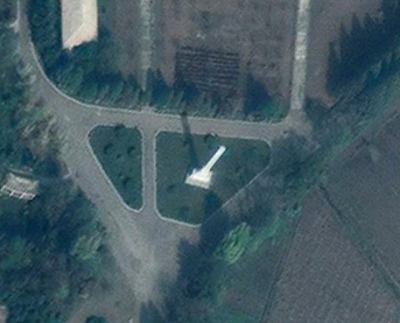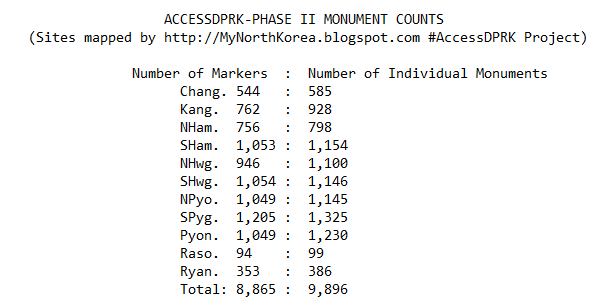As has become tradition with each new map release, here is a list of what's inside North Korea. Although this only reflects what the 2023 Pro Map captured, with over 70,500 sites mapped and organized into 100+ different types of location, AccessDPRK has sought to locate and describe every important military, economic, and cultural site within North Korea.
This latest release also gives me the opportunity to discuss in greater detail what the map contains as well as describe the improvements between this version and the 2021 version.
Without repeating the full backstory to AccessDPRK (which can be found throughout the blog), I began mapping the country in late 2012 as a hobby. Since then, it has ballooned into a methodical mapping project with this associated blog to share the various findings in detail.
The AccessDPRK blog currently has 167 articles which would take up around 1,160 printed pages. I have also written for several other sites including NK News, Asia Times, and 38 North, and AccessDPRK discoveries have been reported on or cited by Radio Free Asia, Voice of America, DailyNK, UPI, Asahi Shimbun, Nikkei, The Atlantic, RAND Corp., and numerous others.
I've also been able to provide professional services to nearly a dozen of the top human rights, nonproliferation, and GIS organizations in the world.
Within the 2023 Pro Map update, more than 70,500 sites are included. This is a net increase of over 17,000 sites compared to the first free nationwide map that I made available back in 2017, when considering all the different changes that have occurred since.
With this update, I have tried to focus on mapping out changes specific to Kim Jong-un's rule as well as monitoring the evolving infrastructure changes due to COVID-19.
As with all my North Korea maps, the file is organized into four main divisions: monuments, military, domestic, and nationwide. The item counts that I've added further below gives even more details, but the general organization of the map is as follows.
The monuments folder is broken down by province and includes folders for Towers of Immortality and a folder for all other monuments. Many of the locations have notes on the type of monument they are (mural, statue, etc.) as well as dates for their construction.
The military folder is broken down by province and there is one for the DMZ. In total, there's over 40 subfolders for specific types of places like anti-aircraft artillery positions, navy bases, military storage sites, tunnels, etc.
The domestic folder is broken down by province and also contains over 40 subfolders for specific types of places like dams, electrical substations, factories, markets, elite housing, schools, train stations, etc.
Both the military and domestic provincial folders also have an "uncategorized" subfolder that contains numerous other sites of interest that didn't warrant having their own dedicated folder (typically because there were just a handful of sites). And, most provinces also have at least one other folder that contains places unique to that province.
For the nationwide folder, that contains ten categories of places that I felt were better organized together instead of being spread out among each provincial folder. Nine categories would be considered "domestic" and one (the folder for ballistic missile bases) would normally be in the military folder.
Compared to the 2021 Pro Map, this update is only 9% larger; however, there were several thousand internal changes to existing sites along with the 9% of newly mapped ones. I go through some of those specific changes below.
Monuments
The 2023 Pro Map includes 711 additional monuments over the 2021 version. This is largely due to updated imagery compared to what was available at the end of 2020, when I was finalizing the 2021 map (released that January). But there are also examples of monuments being constructed throughout 2021-23 (and those construction dates are included). I was also able to remove a few monuments that had been demolished, and to move the position of the icon for several other monuments that were moved to new locations.
Additionally, and this goes for the military and domestic sections as well, I tweaked the position of hundreds (if not more) of icons to address the "drift" that happens when Google Earth updates its imagery. The images are rarely laid along the precise same coordinates so, after a few years, the Google Earth icon's position may no longer exactly match the position of the object in the image - sometimes by as much as 10 meters. So, I tried to make as many of those corrections as possible.
In the process of updating the monuments folder, I noticed some clear construction trends and periods of greater building activity. I've already written two detailed reports (2019 and 2021) on the monuments in North Korea, but I may write one last one in the future that will discuss these observations in more detail.
Military
I want to add a few notes to help with context and prevent any confusion.
While most of the categories are indeed individual sites (there are 1,520 distinct electrical substations for example), some of the categories include not just the primary location but also sites within those places. A great example of this is that there are not 434 prisons in the country. There's 67 known, suspected, and former prisons that I was able to locate. And many of those prisons include detailed maps that also mark where the guard huts are, where prisoner housing is, and so on. So, one prison may be represented by 20+ items, and that's how I get to 434 total sites within the prison category.
The categories that have these more detailed folders are prisons, missile bases, some historic sites, several of the "elite compounds", and a few factories. Additionally, some of the "province only sites" include multiple sites per place. This is especially true in Pyongyang which has the most of these province-only sites. An example is the Ryongsong Residence, which located within the "province only" folder, but that one residence includes 47 detailed sites within its folder. So, while there are 1,043 markers within the whole "province only" category, they're only representing ~300 primary places as several of those primary places have numerous sites marked within.
Lastly, in some cases I did not try to map every single one of the sites within a category. There are notes in the respective folders saying this, but they are: irrigation pumping stations, water supply, factories, agricultural sites, internal security checkpoints, parks, and gates. I tried to map a majority of sites and all of the important ones with the exception of the water supply sites, agricultural sites, internal checkpoints, and gates. For those, I wanted to give a representative sample and to locate major places. I only marked gates in cases where a facility was large and the main entrance could be difficult to find, and in cases where the gate itself was interesting/large.
I would like to thank my current Patreon supporters who help make all of this possible: Alex Kleinman, Amanda Oh, Donald Pierce, Dylan D, Joe Bishop-Henchman, Jonathan J, Joel Parish, John Pike, Kbechs87, Russ Johnson, and Squadfan.



































